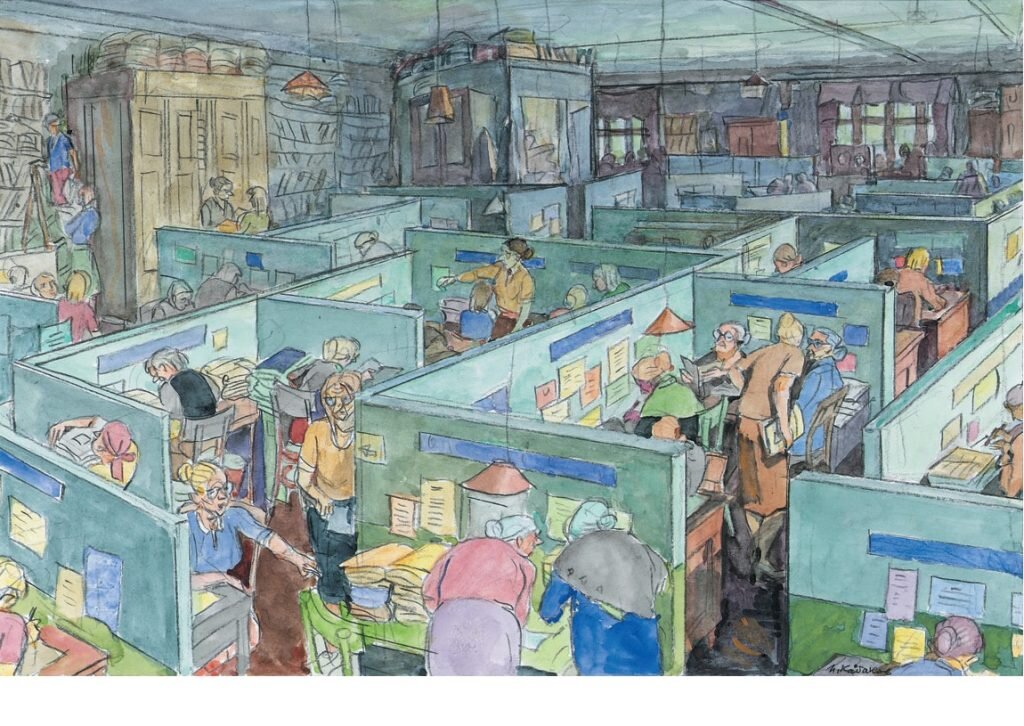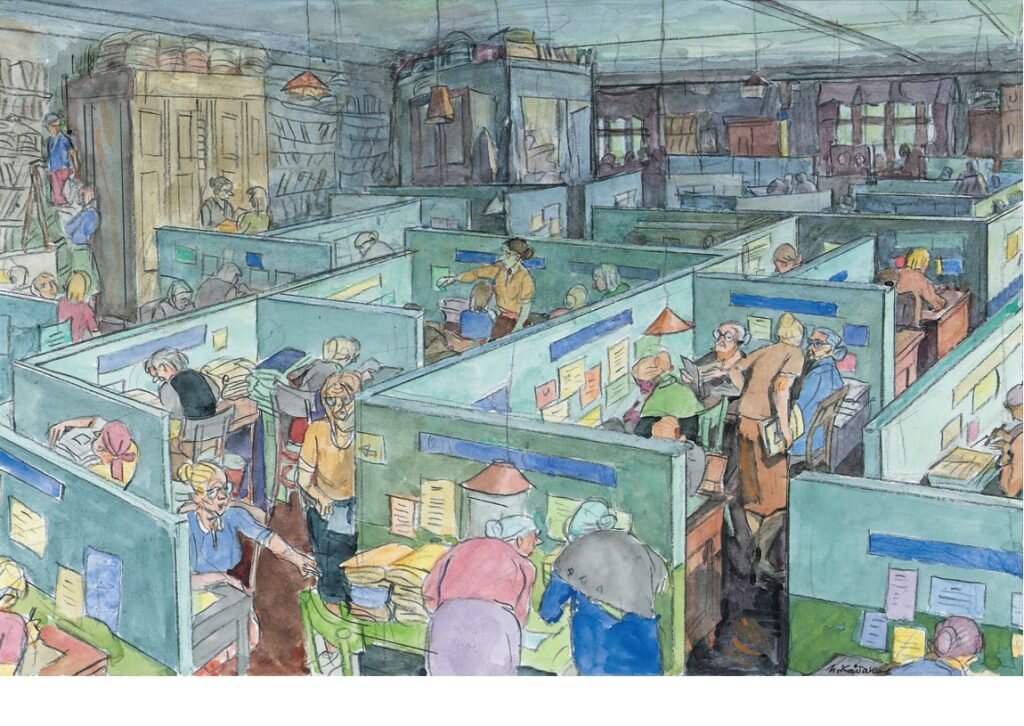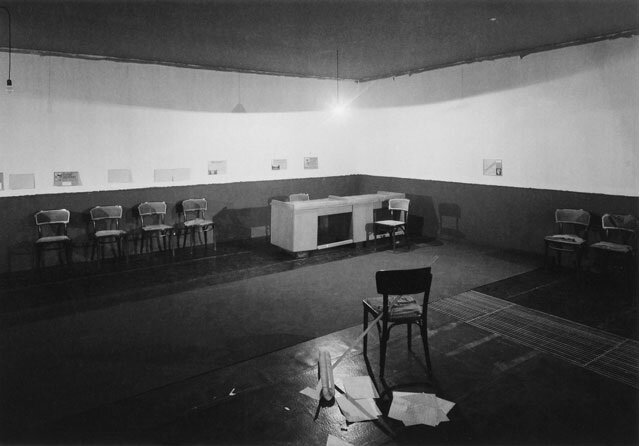The Big Archive
YEAR: 1993
CATALOGUE NUMBER: 66
PROVENANCE
Collection of the artist
EXHIBITIONS
Amsterdam, Stedelijk Museum
Ilya Kabakov. Het Grote Archief, 29 Jan 1993 — 28 Mar 1993
DESCRIPTION
The installation The Big Archive belongs to the group of installations which, all together, form one complete super installation, The Russian World.
List of installations that are included in The Russian World:
The Communal Kitchen
The Communal Apartment
The Man Who Flew Into His Picture
The Man Who Flew Into Space From His Apartment
The Man Who Never Threw Anything Away (The Garbage Man)
The Collector
The Ship
The Mental Institution or the Institute of Creative Research
Labyrinth. My Mother’s Album
We Are Leaving Here Forever
The Red Wagon
The Bridge
The Toilet
My Motherland. The Flies.
Exhibition of a Book
Collected altogether (more in the imagination than in reality, because it would be necessary to sacrifice a small city for them) they are supposed to create the image of a ‘Russian World,’ a complete and independent cosmos. (However, why ‘Russian’? It should be called ‘Soviet,’ a ‘Soviet Cosmos,’ but this difference is for another conversation.) The core of the installation The Big Archive, as in the other installations, is a big, closed space, an entire system of a few such spaces. The viewer is going through them as through a labyrinth, where the beginning of such a journey is different from the end. The contents and the meaning also change during this movement. And, of course, the main part is the relation between the atmosphere of created space (where everything was changed: the walls, the ceilings, color, lighting, sound) and the objects, which are placed in this atmosphere.
The main objects of this installation are: booths for filling out papers (certificates, etc.); tables, shelves and chairs; barriers which divide the whole space, an enormous amount of papers lying on the tables, glued to the stands, or simply nailed to the walls everywhere, a sea of all kinds of papers in which the person who has wound up there incidentally can easily drown. The viewers who are wandering through this labyrinth, barely visible to each other over the barriers, also could become the objects in such an atmosphere.
First Room.1 This is the entrance to the installation. The light, the walls, and the ceiling are left unchanged, and because of the large quantity of questions (placed on the walls and on the tables) which are addressed to the viewer, he becomes aware of what he is going to see.
Second Room.2 This room has a specially built ceiling (the height is 3.15 meters) and looks gray, cheerless, bureaucratic. The room is dimly lighted by six ‘bare’ bulbs without lampshades. The ceiling and walls are painted gray, and the bottom of the walls is painted a dark brown color. There are three booths placed by one of the walls, so people can walk in and fill out the papers. The samples and instructions hang on the walls. In each booth is a table and a chair and in front of the table stands something like a box where the person who filled out these papers can place them. Each booth is only for a specified category of visitors: one booth for people older than seventy, another one for city residents, etc. Which booth is for which category of people is specified above the entrance.
Third Room.3 The character of this room is exactly like that of room No. 2 – the same gray ceiling of the same height, the same kind of light, but instead of three booths, there are five. There is the same notice in front of each of them: what kind of visitor is this booth intended – for ‘sick people,’ for ‘people dissatisfied with their housing arrangements,’ for ‘those constructing plans,’ for ‘people living permanently in villages,’ for ‘people who have been in jail.’ Everyone has to fill out some report, answer some questions, sign something.
Fourth Room.4 One room follows the other: the viewer enters the next one with the same atmosphere as the previous one. But instead of the booths, this room is divided by barriers, which transform the whole space into a complicated labyrinth. There are tables with chairs standing next to the barriers. Each table has a notice telling the visitor to whom he must go for each problem. And each ‘table’ is ‘receiving’ only a certain kind of ‘applicant,’ who is required to have filled out and answered all questions on the papers in the booth: ‘employees,’ ‘teachers,’ ‘workers,’ ‘servicemen,’ … The viewer is immersed in the atmosphere of a cheerless, perpetually working office. He reads the notices and papers on the tables and becomes a participant in this endless process: after receiving a signature in one place, it’s necessary again to fill out the paper and to go back to another table, to get another signature, and in search of the ‘necessary’ table he must walk through the endless labyrinth.
Fifth Room.5 This room repeats the fourth room and, in spite of a different arrangement of the barriers and the tables, different notices, the same office work is going on. It must be said that, periodically, in the air can be heard a voice which sounds like a radio (like in an airport or train station), and it gives some information or direction, but as it often happens, it is impossible to understand exactly what is said.
Sixth Room.6 The viewer arrives here after visiting a dull and overcrowded office. By contrast, this room is almost empty. This is the authorities’ room, where people come for the ‘final’ signature. In the far end, opposite the entrance, stands a big, long table, lit by a lamp (the rest of the room is dimmed). The row of chairs by the walls are for the visitors who are waiting for a signature. There are fewer instructions on the walls, but the ones that remain tell in which order to move to the various authorities that are present in the room. Here is the main junction of this installation, its ‘contrapoint’ – a magic activity is going on here: your destiny is decided.
Seventh Room.7 The exit from the authorities’ room takes you to another space, a low and long corridor built like a labyrinth. The ceiling of the corridor is lower than the ceiling in the other rooms (2.40 meters), and it is dimly illuminated by light bulbs hanging along the length of the corridor. On the walls are hanging new rules and instructions, but by now the viewer feels that there is an exit at the end which he expects to see behind every ‘turn’ of the endless corridor.
Eighth Room.8 The entrance comes suddenly. In the walls of the corridor, which resembles a rectangular tube (pipe), splits and cracks suddenly appear. The walls are not solid anymore, and finally, there are no walls at all, they are lying on the floor as simple boards. The viewer finds himself in a big bright space (a regular gallery space) and feels like a person who walks into the daylight from a strange, painful dream in which he was just deeply submerged.
Ninth Room.9 Through the door opposite to the left of the corridor, the viewer again enters the room where he started his journey through the installation and where his long and strange voyage to The Big Archive is finished.
Images
Literature









